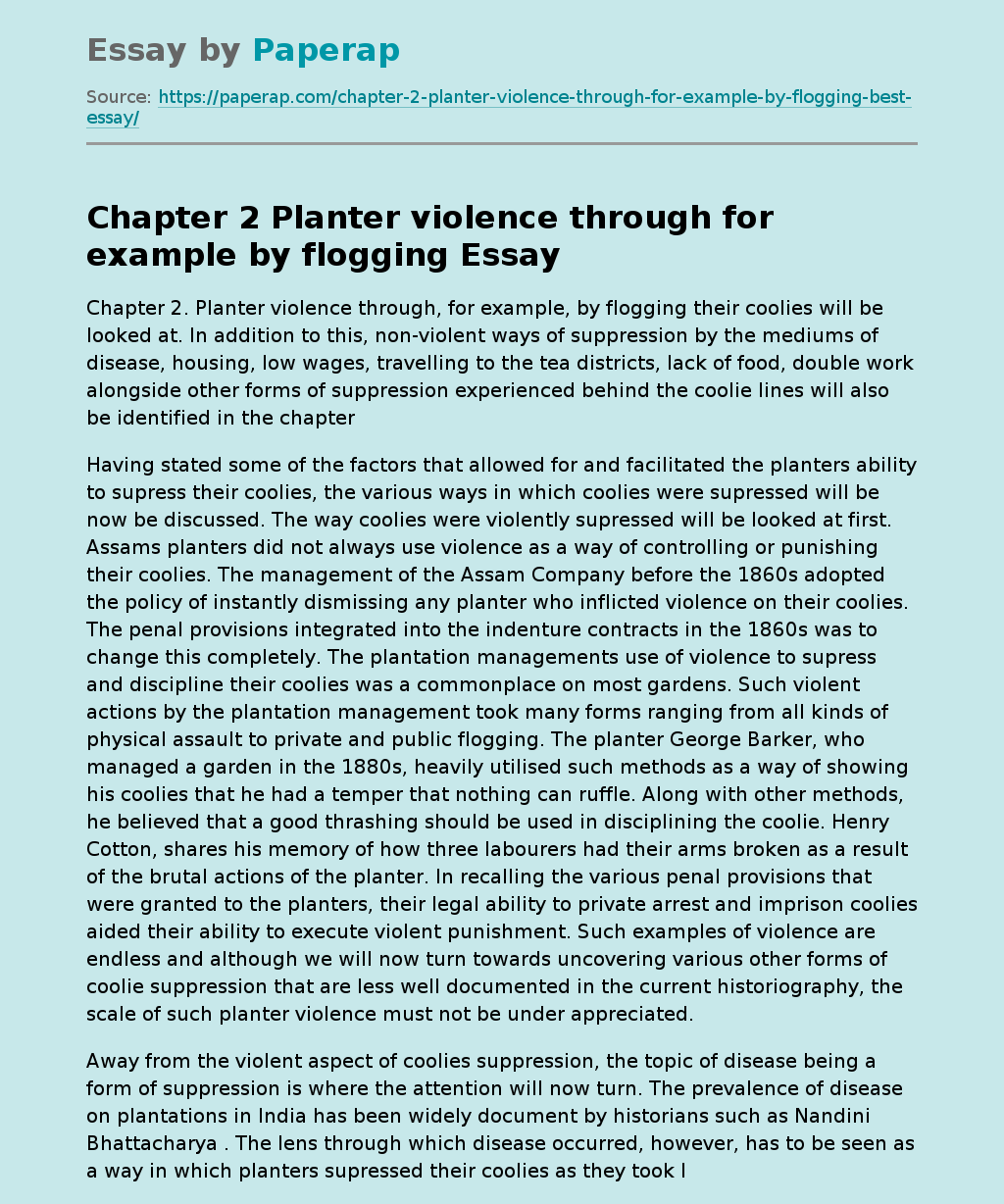Chapter 2 Planter violence through for example by flogging
The following sample essay on “Chapter 2 Planter violence through for example by flogging”: factors of coolies suppression and violence.
Planter violence through, for example, by flogging their coolies will be looked at. In addition to this, non-violent ways of suppression by the mediums of disease, housing, low wages, travelling to the tea districts, lack of food, double work alongside other forms of suppression experienced behind the coolie lines will also be identified in the chapter.
Having stated some of the factors that allowed for and facilitated the planters ability to supress their coolies, the various ways in which coolies were supressed will be now be discussed.
The way coolies were violently supressed will be looked at first. Assams planters did not always use violence as a way of controlling or punishing their coolies. The management of the Assam Company before the 1860s adopted the policy of instantly dismissing any planter who inflicted violence on their coolies. The penal provisions integrated into the indenture contracts in the 1860s was to change this completely.
The plantation managements use of violence to supress and discipline their coolies was a commonplace on most gardens. Such violent actions by the plantation management took many forms ranging from all kinds of physical assault to private and public flogging.
The planter George Barker, who managed a garden in the 1880s, heavily utilised such methods as a way of showing his coolies that he had a temper that nothing can ruffle. Along with other methods, he believed that a good thrashing should be used in disciplining the coolie.
Henry Cotton, shares his memory of how three labourers had their arms broken as a result of the brutal actions of the planter. In recalling the various penal provisions that were granted to the planters, their legal ability to private arrest and imprison coolies aided their ability to execute violent punishment. Such examples of violence are endless and although we will now turn towards uncovering various other forms of coolie suppression that are less well documented in the current historiography, the scale of such planter violence must not be under appreciated.
Away from the violent aspect of coolies suppression, the topic of disease being a form of suppression is where the attention will now turn. The prevalence of disease on plantations in India has been widely document by historians such as Nandini Bhattacharya . The lens through which disease occurred, however, has to be seen as a way in which planters supressed their coolies as they took little measures in trying to reduce mortality. The tea industrys seemingly complete disregard for the legislation that tried to protect coolies health and sanitation began with the traveling to the tea districts. Varma reports how the steamers commuting on the river Brahmaputra usually took longer that the passages of the coolie ships to Mauritius and that the passage often reported significantly higher rates of morality in comparison to other indenture locations. Recorded for the year of 1861, mortality rates on steamers heading for Assam were estimated to be between 20 to 50 percent.
Guha supports this by saying that between 15 December 1859 to 21 November 1861, the Assam Company brought 2,272 recruits from outside, of whom 250 or 11 per cent died on the way. Although other diseases ran rife on these steamers, cholera was by far one of the worst to cause such mortality. The awful impact cholera had can be observed, for example, by the steamer Scinde which set sail for Assam in late December 1882. Cholera killed 40 of the just over 500 coolies that had originally embarked the ship. Asides from tea companies disregard for introducing sanitary provisions on the steamers, their complete lack of coolies wellbeing is perhaps further emphasised by the fact that many coolie deaths were caused by drowning.
The Tea Companys suppression of the coolies, in medical terms, continued when the coolies reached their posts in Assam whereby excessive mortality remained a continuous problem. Like with the health care regulations tea companies ignored regarding the sanitary conditions coolies travelled to Assam in, the companies largely ignored the legal provisions planters were instructed to follow regarding the sanitary conditions on the gardens. This was because heath care expenditure was seen as an unnecessary economic expense by the planters. The ways in which tea plantations in Assam can be seen as being unsanitary behind the coolie lines are endless.
One such example can be made by understanding that adequate water provisions were not implemented on the majority of Assams gardens which was seen as the main cause for high levels of mortality that resulted from diarrhoea, cholera and dysentery. In addition to this, the hospitals that were created on the plantations were grossly under provisioned and medical care was often given by coolie doctors who lacked adequate medical training. The planters lack of actions to do anything to reduce the extremities of the unhygienic conditions of the huts in the coolie lines that easily spread disease provides another example of how coolies were medically supressed.
Directly connected to why high mortality rates were recorded on Assams plantation, asides from poor medical facilities and unhygienic conditions, was the fact that coolies were constantly supressed through undernourishment and were overworked. Such a combination of factors makes the fighting off disease and infection an extremely arduous task. And yet again as the tea companies had the ability to improve these aspects of life for the coolies, but chose not to, makes these factors a medium of suppression.
Chapter 2 Planter violence through for example by flogging. (2019, Nov 16). Retrieved from https://paperap.com/chapter-2-planter-violence-through-for-example-by-flogging-best-essay/

